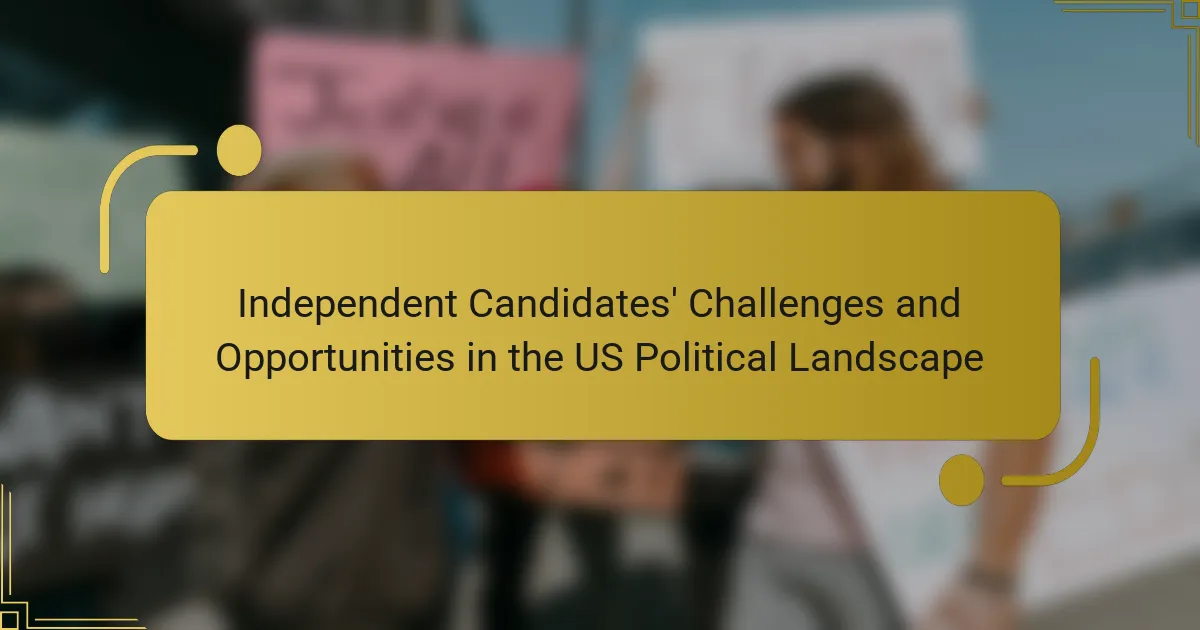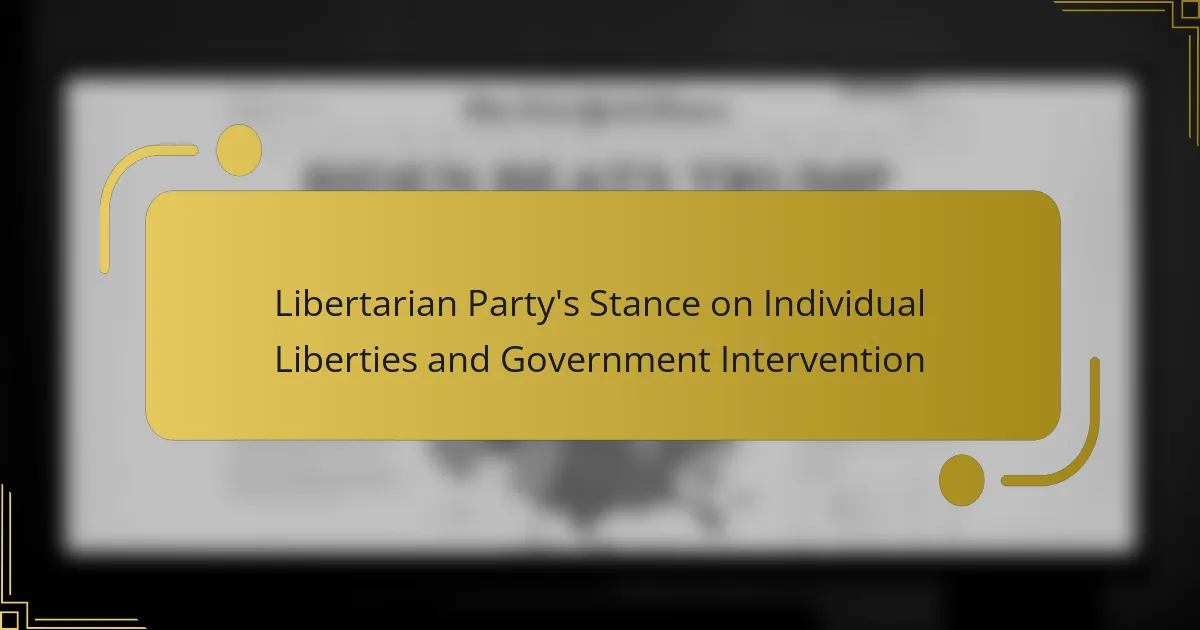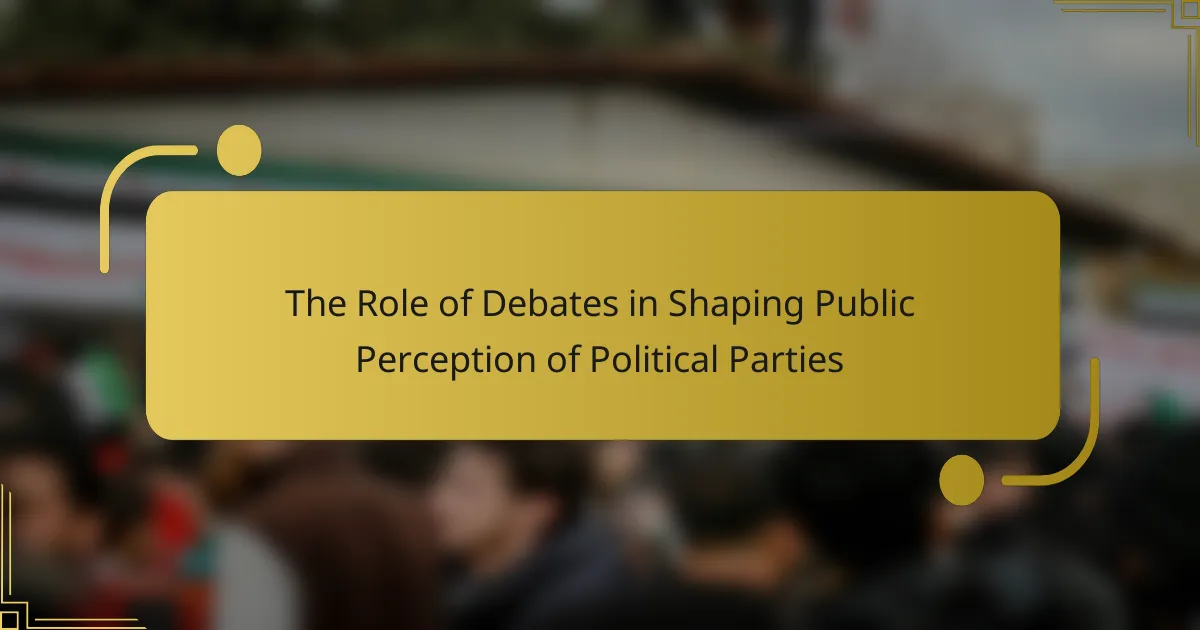Independent candidates in the US political landscape encounter various challenges that hinder their electoral success. Key obstacles include stringent ballot access requirements, limited funding compared to major party candidates, media bias favoring established parties, and voter perception that often undermines their credibility. Additionally, the two-party system structurally disadvantages independents, complicating their ability to compete effectively. However, opportunities exist for these candidates to connect with disenchanted voters, particularly through grassroots movements, social media engagement, and addressing specific local issues. By leveraging these strategies, independent candidates can enhance their visibility and build support in a competitive environment.

What are the challenges faced by independent candidates in the US political landscape?
Independent candidates in the US political landscape face several significant challenges. One major challenge is ballot access. Many states have stringent requirements for independent candidates to qualify for the ballot. This can include gathering a large number of signatures from registered voters within a limited timeframe.
Another challenge is limited funding. Independent candidates often struggle to raise money compared to candidates from established parties. This financial disadvantage can hinder their ability to campaign effectively and reach voters.
Additionally, independent candidates face media bias. Media coverage tends to favor major party candidates, making it difficult for independents to gain visibility. This lack of exposure can affect their overall recognition among the electorate.
Voter perception is also a challenge. Many voters may view independent candidates as less viable or credible than those from major parties. This perception can result in lower support during elections.
Finally, the political system itself poses a challenge. The US electoral system is largely structured around a two-party system, which complicates the ability of independent candidates to compete. This structural disadvantage limits their chances of winning office.
Why do independent candidates struggle to gain traction in elections?
Independent candidates struggle to gain traction in elections due to limited access to resources and voter recognition. Major political parties dominate funding and media coverage. This results in a lack of visibility for independent candidates. Voters often perceive them as less viable options. Additionally, the electoral system favors a two-party structure. This system includes mechanisms like winner-takes-all voting. Such mechanisms reinforce the dominance of established parties. Historical data shows that independent candidates rarely win significant offices. For example, in the 2020 U.S. presidential election, independent candidates received only about 1% of the total vote. These factors collectively hinder independent candidates’ ability to compete effectively.
What systemic barriers exist for independent candidates?
Systemic barriers for independent candidates include restrictive ballot access laws. Many states require independent candidates to gather a significant number of signatures to qualify for the ballot. This process can be costly and time-consuming. Additionally, independent candidates often lack access to the same funding sources as major party candidates. They face difficulties in securing donations and support from political action committees. Media coverage tends to favor established party candidates, limiting visibility for independents. Voter perceptions also pose a barrier, as many voters feel they must choose between the two major parties. These systemic issues create challenges for independent candidates seeking to compete effectively in elections.
How do voter perceptions impact independent candidates?
Voter perceptions significantly impact independent candidates by influencing their electability and campaign strategies. Positive perceptions can lead to increased support and funding. Conversely, negative perceptions may hinder their ability to gain traction in elections. Independent candidates often struggle with name recognition compared to established party candidates. Surveys show that many voters view independents as less viable, affecting their willingness to vote for them. A study by the Pew Research Center found that only 30% of voters consider independent candidates a serious option. This perception shapes the overall political landscape and can limit the diversity of candidate choices.
What role do party affiliations play in the challenges of independent candidates?
Party affiliations significantly impact the challenges faced by independent candidates. Independent candidates often lack the institutional support that party-affiliated candidates receive. This absence of support can hinder fundraising efforts and access to vital resources. Research shows that candidates from established parties benefit from party networks and voter bases. In contrast, independent candidates must build their support from scratch. Additionally, many voters have strong loyalties to specific parties, making it difficult for independents to gain traction. Studies indicate that independents often struggle to be included in debates and media coverage, limiting their visibility. Overall, party affiliations create systemic barriers that complicate the electoral process for independent candidates.
How do major political parties influence the electoral process for independents?
Major political parties influence the electoral process for independents by shaping the political landscape and electoral rules. They often control ballot access, making it difficult for independents to qualify for elections. Major parties typically have established networks and resources that independents lack. This includes funding, voter outreach, and media coverage. Furthermore, major parties can influence public perception and voter behavior through their platforms and messaging. Studies show that independents often struggle to gain visibility in a system dominated by two parties. This dominance can lead to voter apathy towards independent candidates, as many voters feel their chances of winning are slim. Overall, major political parties create significant barriers that affect the electoral viability of independents.
What are the implications of closed primaries for independent candidates?
Closed primaries limit independent candidates’ ability to participate in party nominations. In states with closed primaries, only registered party members can vote in their party’s primary elections. This exclusion reduces the voting base for independent candidates. Consequently, independent candidates may struggle to gain visibility and support. Research shows that states with closed primaries tend to favor established party candidates. For example, in 2020, only 15% of independent voters participated in closed primaries. This statistic illustrates the disadvantage faced by independents in these systems. Overall, closed primaries create significant barriers for independent candidates seeking to compete effectively.

What opportunities exist for independent candidates in the US political landscape?
Independent candidates in the US political landscape have opportunities to appeal to disenchanted voters. They can capitalize on growing dissatisfaction with the two-party system. Recent polls indicate that a significant portion of the electorate identifies as independent. This trend allows independent candidates to position themselves as alternatives to mainstream options. Additionally, advancements in technology facilitate grassroots fundraising and outreach. Social media provides platforms for independent candidates to connect with voters directly. Furthermore, some states have adopted ranked-choice voting, which can benefit independent candidates by allowing more diverse choices. These factors contribute to a more favorable environment for independent candidates seeking election.
How can independent candidates leverage social media for campaigning?
Independent candidates can leverage social media for campaigning by building a strong online presence. They can use platforms like Twitter, Facebook, and Instagram to connect with voters directly. Engaging content, such as videos and infographics, can help convey their message effectively. Social media allows for real-time interaction, fostering a sense of community among supporters.
Data shows that 69% of Americans use social media, making it a vital tool for outreach. Targeted ads can help reach specific demographics, increasing campaign visibility. Independent candidates can also utilize hashtags to join larger conversations and gain traction. By sharing personal stories and experiences, they can humanize their campaign and resonate with voters.
Research indicates that campaigns that actively engage on social media can increase voter turnout by as much as 10%. This underscores the importance of a strategic social media approach for independent candidates.
What strategies can independent candidates use to engage with voters online?
Independent candidates can engage with voters online through targeted social media campaigns. They should utilize platforms like Facebook, Twitter, and Instagram to share their messages. Engaging content such as videos, infographics, and live Q&A sessions can attract attention. Building a community through interactive posts encourages voter participation. Independent candidates can also leverage email newsletters to provide updates and solicit feedback. Collaborating with influencers can expand their reach. Data from the Pew Research Center indicates that 69% of adults use social media, making it a vital space for outreach.
How does social media change the dynamics of political campaigning for independents?
Social media significantly alters the dynamics of political campaigning for independents. It provides a platform for direct engagement with voters. Independent candidates can bypass traditional media gatekeepers. This allows them to present their messages more authentically. Social media also enables targeted advertising to specific demographics. According to a 2020 Pew Research study, 69% of Americans use social media. This broad reach helps independents connect with a larger audience. Moreover, social media facilitates grassroots organizing and mobilization. Candidates can rally supporters quickly and effectively through shares and retweets.
What unique platforms can independent candidates adopt to differentiate themselves?
Independent candidates can adopt unique platforms such as grassroots fundraising, social media engagement, and issue-based campaigns. Grassroots fundraising allows them to connect with local supporters and build a solid financial base. Social media engagement facilitates direct communication with voters, bypassing traditional media filters. Issue-based campaigns enable independent candidates to focus on specific topics that resonate with constituents, such as climate change or healthcare reform. These strategies help them stand out in a crowded political landscape. For example, in 2020, independent candidates who utilized social media effectively saw increased voter engagement and support.
How can independent candidates appeal to disillusioned voters?
Independent candidates can appeal to disillusioned voters by addressing their specific concerns and values. They should focus on transparency and integrity in their campaigns. This builds trust with voters who feel let down by traditional parties.
Engaging in grassroots efforts can also resonate with disillusioned voters. This approach creates a sense of community and shared purpose. Independent candidates must articulate clear, actionable policies that differ from mainstream options.
Highlighting unique perspectives on key issues can attract attention. Many disillusioned voters seek alternatives to polarized politics. Independent candidates should leverage social media to connect directly with voters.
According to a 2020 Pew Research study, 50% of Americans express frustration with the political system. Addressing these sentiments can strengthen their appeal. By positioning themselves as viable alternatives, independent candidates can tap into this growing voter base.
What issues resonate most with the independent voter base?
Independent voters are primarily concerned with issues like healthcare, the economy, and climate change. Many independent voters prioritize affordable and accessible healthcare options. Economic stability and job creation are also significant concerns for this group. Climate change and environmental policies resonate strongly, reflecting a desire for sustainable practices. Additionally, independent voters often seek political accountability and transparency. A 2020 survey by the Pew Research Center indicated that 61% of independents view healthcare as a top priority. The same survey found that 54% emphasize economic issues, while 48% highlight climate change as critical. These statistics illustrate the pressing issues that shape the independent voter base’s preferences.

How can independent candidates overcome challenges and seize opportunities?
Independent candidates can overcome challenges and seize opportunities by leveraging grassroots support and building strong community connections. Grassroots movements allow candidates to engage directly with voters, fostering trust and loyalty. They should utilize social media platforms to amplify their message and reach a broader audience. This approach enables them to connect with younger voters who prefer digital communication.
Additionally, independent candidates can focus on specific issues that resonate with the electorate. By addressing local concerns and advocating for policy changes, they can differentiate themselves from established parties. Collaborating with local organizations can also enhance their visibility and credibility.
Fundraising is another critical area where independent candidates must excel. They can seek small donations from a large number of supporters, which can be more effective than relying on large contributions from a few donors. This method not only raises funds but also builds a committed base.
Moreover, participating in debates and public forums allows independent candidates to showcase their platforms and engage directly with voters. This visibility can help them gain traction in a competitive political landscape.
Finally, forming alliances with like-minded individuals or groups can expand their reach and resources. This collaborative approach can strengthen their campaign and provide additional support in overcoming challenges.
What best practices should independent candidates follow to build a successful campaign?
Independent candidates should focus on building a strong grassroots campaign. Engaging with local communities fosters trust and support. Utilizing social media effectively can enhance visibility and outreach. Developing a clear and concise message resonates with voters. Establishing a robust volunteer network aids in campaign efforts. Fundraising through diverse channels ensures financial stability. Collaborating with local organizations can expand influence and resources. Regularly assessing campaign strategies allows for timely adjustments and improvements.
What role does grassroots organizing play in an independent candidate’s success?
Grassroots organizing is crucial for an independent candidate’s success. It helps build a strong community base and mobilizes local support. This approach allows candidates to connect directly with voters. Engaging constituents fosters trust and loyalty. According to a study by the Harvard Kennedy School, grassroots efforts can significantly increase voter turnout. Independent candidates often lack the financial backing of major parties. Therefore, grassroots organizing compensates by leveraging community relationships. Successful campaigns like that of Bernie Sanders demonstrate the effectiveness of grassroots strategies. They mobilized thousands of volunteers and small donors, showcasing the power of community engagement.
How can independent candidates effectively fundraise without party support?
Independent candidates can effectively fundraise without party support by leveraging grassroots campaigns and digital platforms. They should utilize social media to reach potential donors and build a community of supporters. Creating a compelling narrative around their campaign can engage individuals who resonate with their message.
Utilizing crowdfunding platforms allows them to gather small contributions from a large number of supporters. Hosting local events can foster connections and encourage direct donations. Independent candidates can also seek out endorsements from influential figures to enhance credibility and attract funding.
According to a study by the Pew Research Center, nearly 60% of Americans prefer candidates who are not affiliated with major parties, indicating a potential donor base eager to support independent candidates.
What lessons can be learned from successful independent candidates in recent elections?
Successful independent candidates in recent elections demonstrate the importance of grassroots campaigning. They often rely on local support and community engagement to build their platforms. This approach allows them to connect authentically with voters. Additionally, successful independents utilize social media effectively to reach a wider audience. They often present clear, specific policy proposals that resonate with constituents. Data from the 2020 elections showed that independents who focused on local issues gained significant traction. Furthermore, they emphasize transparency and accountability, which builds trust among voters. Overall, these strategies highlight the potential for independents to thrive in a polarized political environment.
What strategies did they implement that contributed to their success?
Independent candidates implemented grassroots campaigning strategies that significantly contributed to their success. They focused on building strong local networks to engage voters directly. Utilizing social media platforms allowed them to reach wider audiences without substantial funding. They prioritized issue-based messaging that resonated with constituents’ concerns. Additionally, they fostered community involvement through town hall meetings and public forums. These strategies helped them establish credibility and visibility in a competitive political landscape. For instance, a successful independent candidate in the 2020 elections raised funds through small donations, which showcased broad grassroots support.
How did they navigate the challenges faced by independent candidates?
Independent candidates navigated challenges by leveraging grassroots campaigns and building strong community connections. They often utilized social media to reach voters directly, bypassing traditional party structures. Fundraising through small donations was essential for their financial viability. Many independent candidates focused on specific issues to differentiate themselves from major party candidates. They also formed alliances with like-minded organizations to amplify their message. Additionally, they participated in debates and forums to gain visibility. The ability to adapt messaging to local concerns helped them resonate with constituents. These strategies enabled independent candidates to compete effectively in a challenging political landscape.
Independent candidates in the US political landscape encounter various challenges, including ballot access, limited funding, media bias, and voter perception influenced by party affiliations. They struggle to gain traction due to systemic barriers that favor established parties and the two-party electoral system. However, opportunities exist for independents to appeal to disillusioned voters through grassroots organizing, social media engagement, and issue-based campaigns. The article explores these challenges and opportunities, providing insights into strategies that independent candidates can implement to enhance their visibility and effectiveness in elections.



